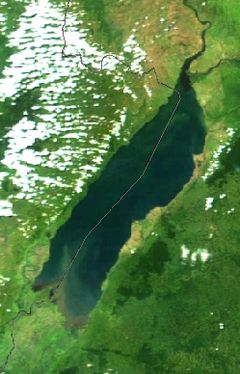
Lake Albert (Africa)
Did you know...
SOS believes education gives a better chance in life to children in the developing world too. Sponsor a child to make a real difference.
| Lake Albert | |
|---|---|
 |
|
| 2002 NASA MODIS satellite picture. The dotted grey line is the border between Congo (DRC) (left) and Uganda (right). | |
| Coordinates | 1°0′N 30°5′E |
| Primary inflows | Victoria Nile |
| Primary outflows | Albert Nile |
| Basin countries | Democratic Republic of Congo, Uganda |
|
|
|
| Max. length | 160 km |
| Max. width | 30 km |
| Surface area | 5,300 km² |
| Average depth | 25 m |
| Max. depth | 58 m |
| Water volume | 132 km³ |
| Surface elevation | 615 m |
|
|
|
| Settlements | Butiaba, Pakwach |
| References | |
Lake Albert – also Albert Nyanza and formerly Lake Mobutu Sese Seko – is one of the Great Lakes of Africa. It is Africa's seventh largest lake, and ranks as the world's twenty-third largest lake by volume.
Geography
Lake Albert is located in the centre of the continent, on the border between Uganda and the Democratic Republic of the Congo (formerly Zaire). Lake Albert is the northernmost of the chain of lakes in the Great Rift Valley; it is about 160 km (100 mi) long and 30 km (19 mi) wide, with a maximum depth of 51 m (168 ft), and a surface elevation of 619 m (2,030 ft) above sea level.
Lake Albert is part of the complicated system of the upper Nile. Its main sources are the Victoria Nile, ultimately coming from Lake Victoria to the southeast, and the Semliki River, which issues from Lake Edward to the southwest. The water of the Victoria Nile is much less saline than that of Lake Albert. Its outlet, at the northernmost tip of the lake, is the Albert Nile (which becomes known as the Mountain Nile when it enters Sudan).
At the southern end of the lake, where the Semliki comes in, there are swamps. Farther south loom the mighty Ruwenzori Range, while a range of hills called the Blue Mountains tower over the northwestern shore. The few settlements along the shore include Butiaba and Pakwach.
History
In 1864, the explorer Samuel Baker discovered the lake; he named it after the recently deceased Prince Albert, consort of Queen Victoria. Congolese president Mobutu Sese Seko temporarily named the lake after himself.
Conflict is arising over oil found in Lake Albert. Reserves are estimated at less than 100,000 barrels a day for about 10 years when production starts. Tensions between the DRC and Uganda in early August 2007, largely over the ownership of the small Rukwanzi Island, led to an armed clash that killed a British geologist working for an oil prospector.


